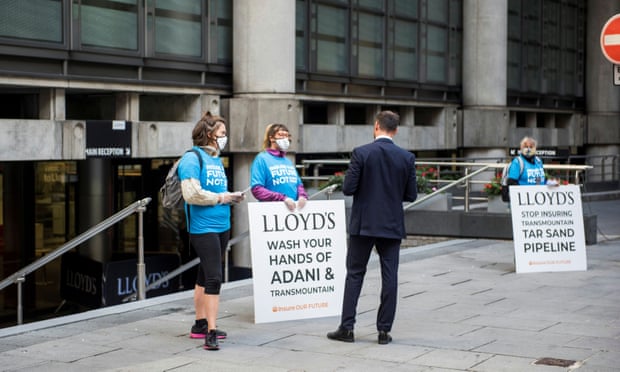 03-09-2020
03-09-2020
Lloyd’s of London reopens building for first time since March

 Insurance Alertss
Insurance AlertssLloyd’s of London reopens building for first time since March
The insurance market Lloyd’s of London has reopened its underwriting room for the first time since March, making it the latest City firm to inch towards normality amid the coronavirus pandemic.
The 334-year-old institution welcomed underwriters and brokers back into the building on Tuesday morning, as part of a phased reopening that will mean running at 45% capacity until further notice to ensure social distancing rules are followed.
It follows a dramatic change for Lloyd’s members, who have traditionally relied on face-to-face deals but have had to conduct most business online or over the phone since the market closed its doors on 19 March, before the UK-wide lockdown.
The reopening was marked by climate protests, as activists called on syndicate members to stop insuring coal and tar sands projects. Campaigners from Insure Our Future hit out at contracts covering the proposed Adani Carmichael coal mine in Australia, Canada’s Trans Mountain tar sands pipeline, and reinsurance for Polish coalmines.
Lloyd’s said while it took the climate crisis “extremely seriously” it did not set underwriting policies for its 90-plus syndicate members. However, the market said it was “committed to building consensus” among members as part of the transition towards a low-carbon economy. Lloyd’s – which usually hosts about 6,000 of its 45,000 workers, brokers and underwriters on any given day – will now rotate between insurance sectors throughout the week in order to manage capacity.
On Tuesdays, members involved in property, terrorism and construction insurance will be the first to take the floor, followed by marine and aviation on Wednesdays. The market has also installed perspex barriers across the underwriting room with slots for contracts to be passed between brokers at what is known as the “box”, where deals are finalised. Digital booths have been installed for contacting members outside the building. Face coverings are mandatory throughout the building, except for at the box.
Only three people will be allowed in a lift at a time, and its cafe is open for takeaway and pre-ordered food and drinks. Lloyd’s has arranged for enhanced cleaning throughout the day, swab tests every two weeks, and “fogging” the building to kill bacteria and viruses every 30 days. Fogging is meant to protect surfaces from contamination for up to a month.
Meanwhile, Lloyds Banking Group (LBG) is relaunching mobile branch services and has started to increase working hours for its mortgage advisers, as it moves into “phase 3” of its Covid strategy. According to a newsletter by LBG’s staff union, Accord, bankers will be able to hold more face-to-face meetings, which will be restricted to vulnerable customers including those over 70 who may otherwise struggle to access phone or online banking. However, the union said staff who were uncomfortable with face-to-face meetings would not be forced to do so.
Bank branch closures are now back on the table, after LBG put its cost-cutting and restructuring efforts on pause during the Covid-19 outbreak. Lloyds is pressing ahead with plans to close 56 branches, originally announced in January, but the lender was not able to confirm how many jobs would be lost as a result. Affected staff were informed on Thursday.
Lloyds is reviewing its office space needs and exploring new ways of working after concluding that 50,000 of its 65,000 staff have worked from home effectively during the pandemic. This could result in office workers using surplus space in its branches going forward.
Source: The Guardian
